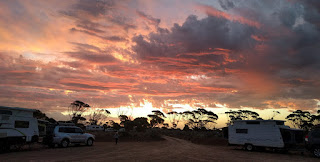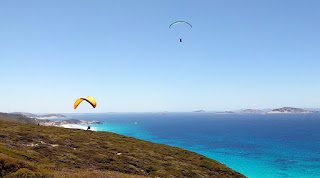December 24 to December 31
 |
| Murphy's Haystack Granite Formations |
Christmas Eve Saturday reached 380C by midday, so
by the time Streaky Bay regained power at 1pm (after a 24 hour power outage
from the previous day’s storm), we happily checked in to the caravan park and
started our air conditioner in the motorhome. We also were able to extend our
stay in the caravan park by a day, so we were staying for three nights, until
Tuesday.
Although only a small seaside town of around 1000 residents,
with one caravan park and one pub, it has a long history dating back to 1839
when explorer Edward John Eyre established a camp. Farming commenced in the
1850’s and an oyster factory in the 1870’s. A surprising number of historic
buildings are restored and still in use throughout the town.
We checked with the pub to see if they were open on
Christmas Day for lunch or dinner, but alas they weren’t after a large booking
cancelled recently.
 |
| More Murphy's Haystack Granite Formations |
Christmas Day Sunday was nice and low key, we walked the bay
trail in the morning before it got too hot, and I went for a paddle on my wave
ski in the bay to keep cool, and to learn the finer skills of blue swimmer crab
hunting. I say hunting because one method to catch them is to arm yourself with
a hooked, rake like implement (and/or a landing type net) and walk around the
shallows (knee to thigh deep) of the bay watching for them to swim by and bury
themselves in the sand. You then “rake” them up to capture them and put the
legal ones in a bucket (which your accomplice carries, or floats on a kayak you
tow around). All very primitive. Three teenagers let me help them by spotting,
and with a bit of practice you can spot them already buried as well as swimming
around.
 |
| Venus Bay Coastline looking South |
The afternoon was again spent hiding away from the 380C
in the air con, and watching storms brew to the north and east of us. The
cyclone that went through Broome was bringing a lot of instability through the
centre of Australia and down to South Australia. We received some strong wind gusts and rain
but most of the weather hit east of us and towards Adelaide. Over the next two
days flooding rain and power outages greatly affected the state to our east.
 |
| Venus Bay Township on the edge of the cliffs |
Monday the rain set in and the wind blew. We did manage a
coastal walk into town but still got wet.
Tuesday was much of the same, and even though we checked out
of the caravan park, we stayed around town and decided that we would overnight
at the low cost ($10) RV area in town. We were surprised that we were on our
own in the camp area, as the caravan park was full. It was also a bit protected
from the wind which was nice.
 |
| Venus Bay cliffs, township and bay in the background |
Wednesday we departed Streaky Bay and drove south to Murphy’s
Haystacks. This is a grouping of interesting, protruding granite formations on
a private farm that have been weathered by wind and rain. The owner made the
area available for tourists with a walking track around the formations.
Further southeast we passed through Port Kenny before
stopping overnight at a secluded rest stop not far out of town.
 |
| Elliston bay and Jetty |
Thursday we drove 10km further to Venus Bay. This small
fishing village is at the mouth of the bay of the same name, and is currently
full for the holiday season. One of the features of this village is the South
Head Walking Trail, a 4km trail around the cliff edge of the ocean and bay.
This may be the most spectacular cliff walk we have done. The photos just don’t
do justice to the overall experience of the headland and landscape.
 |
| Sculptures on the Elliston Coastal Cliffs |
We spent rest of the day walking the jetty and town, I was
keen to go fishing but with 30+km/h winds (and for the foreseeable future) I
had to give it a miss. We returned to the rest area out of town after a
surprisingly enjoyable day. Visit Venus Bay if you pass this way, a hidden gem.
Friday we continued southeast to Elliston. This small
village is situated in a small bay which again has spectacular cliffs lining
the ocean coastline, and (fairly) protected waters within the bay. We decided
to stop here for the New Year’s weekend, one night in their caravan park and
one night at their RV Friendly camp spot at the golf club. The golf club is
high on a hill overlooking the bay and town, and they only prepare the course
for play in the winter months, so it unused for the rest of the year.
 |
| Elliston Coastline, and township on the near side of the bay |
We caught up on washing at the caravan park on Friday, as
well as walked the bay beach next to the jetty. The jetty is currently closed
due to damage caused by the wild storms in September (when the whole of South
Australia lost power). The waves were half way up the light poles along the
jetty (check the photo and try to imagine it). I went for a bike ride along the
southern cliff trail to scope it out, it’s not a loop walk so I wanted to
select a section to walk with Leah on Saturday.
 |
| New Year's Eve sunset, not a bad camp spot, Elliston |
Saturday we drove the northern tourist drive along the
cliffs, a spectacular 10km dirt road with numerous lookouts, and interesting sculpture installations at the lookouts (the one's that survived the September storm). We also walked the
“selected” southern cliff walk. We were as astounded with the cliffs as we were
in Venus Bay. It seems these cliff formations keep going for hundreds of
kilometres south of Streaky Bay (probably an extension of the Bunda Cliff
formations in the Bight?). Saturday night, New Year’s Eve, we had the RV park
at the golf club to ourselves, so we toasted the new year (early) with the
sunset (see photo) as our company.
Sunday we continued the drive southeast, to
explore more awesome cliffs and coastline.









































